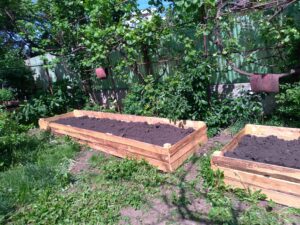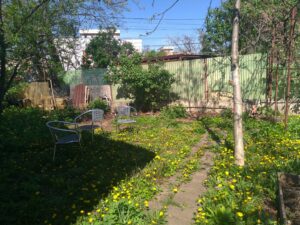Building community through gardening and sharing all the benefits the microbes in the soil have to offer us as well as the food it produces. Gardening in community multiples it’s benefits.
In March, I started to work with others to build a community garden. It’s not a typical community garden where you are assigned an area or plot and then you are wholly responsible for it. Instead, this is coordinated by a few people, with one person providing the space and inviting people into community. Two people build the beds in their spare time, preparing the ground, and then many people plant and nurture the garden. Still, another person shares in creating space for community by organising and cleaning the solarium. With so many hands a lot can get done in a short time. It is truly a cooperative effort.








Gardening together
Gardening alone has many benefits, and gardening together provides even more. With so many people living away from their family of origin and the feelings of isolation that social media can create, there is a real need for solid connection and community. As more people join in for a few hours one day every other week to plant, weed and socialise, the plan is to grow the community – not just plants.
Each person gets to use all their senses throughout the gardening season – smelling and touching the dirt, watching the plants grow, hearing the birds and bees singing nature’s song, and then as the rich colourful fruits and veg come to fruition, they can finally taste the produce. The gardeners also get to share conversation when they feel compelled to or to stay quiet and get present and grounded as we connect and commune with Mama Nature.
The simple act of gardening reminds us of the cycles of life. It helps us to remember that we are interconnected – a part of the vast ecosystem. That remembrance increases our ability to empathise with others and make space in our hearts for compassion.
Gardening in this way allows people to connect, creates friendships and provides companionship. Besides all the delicious food and communing with Mama Nature, you nourish your body, mind and soul.
Symbiosis doesn’t stop there. The intermingling and cooperation extend beyond humans to humans or humans to plants but to the plant life itself through companion planting – plant to plant.
symbiosis – noun /ˌsɪm.baɪˈoʊ.sɪs/
(from the Cambridge Dictionary)
a relationship between two types of animal or plant in which each provides for the other the conditions necessary for its continued existence
Companion Planting
Besides having the good fortune of access to the book Wyman’s Gardening Encyclopedia, so many years ago, my local bookstore had titles like Carrots Love Tomatoes and Roses Love Garlic, where I first learnt about companion planting. Then there was the Farmer’s Almanac and Planting by the Moon too. This was my introduction to companion planting. From the books to practice, I placed the plants together according to age-old wisdom.

Roses love garlic!
Companion planting is a sustainable gardening practice that mimics natural ecosystems, fostering mutually beneficial relationships between different plant species and contributing to healthier, more productive gardens.
Companion plants interact with each other in various beneficial ways. If you want me to write more about companion planting in-depth, leave a comment.
Insects: the good, the bad, and the ugly
Certain plants emit odours or chemicals that repel pests, effectively protecting neighbouring plants. For instance, planting marigolds alongside vegetables can deter nematodes, while aromatic herbs like basil or rosemary can repel mosquitoes and other insects. But you must be careful with what you will choose. Basil isn’t a friendly companion to some veggies.
Several plants attract beneficial insects like ladybugs, lacewings, and bees, which help control pests or pollinate other plants. For example, planting flowers such as alyssum or dill can attract beneficial insects that prey on aphids and caterpillars.
Enhancing soil fertility
Plants such as legumes (e.g., beans, peas, and clover) have symbiotic relationships with nitrogen-fixing bacteria in their root nodules. These bacteria convert atmospheric nitrogen into a form that plants can use, enriching the soil with nitrogen. When planted alongside nitrogen-demanding plants like corn or tomatoes, legumes can enhance soil fertility.
Shade and support
Here is when throwing shade is a good thing. Taller plants may provide shade and support for shorter, more delicate plants. Growing climbing vegetables like beans or peas alongside taller crops such as corn will maximise space and minimise water evaporation from the soil.
Fostering a productive environment
Some companion plants have root systems that differ in depth or spread, reducing competition for nutrients and water. For instance, planting shallow-rooted plants alongside deep-rooted ones can optimise the use of soil nutrients and prevent overcrowding.
Allelopathy
Certain plants release chemicals into the soil that inhibit the growth of competing plants and/or deter pests. For example, planting aromatic herbs like thyme or sage can suppress weed growth through allelopathic effects.

left: thyme, right: sage
Mama Nature knows what she is doing, we simply need to remember her wisdom and act accordingly. Mimicking natural ecosystems and fostering mutually beneficial relationships between different plant species makes for healthier, more productive gardens.
Want to volunteer?
The opportunity is open to anyone who wants to volunteer. And uniquely, Girl Gone International’s Cluj chapter will host their first community gardening events there.
There are currently two ways to participate.

- Directly through Play Space Cluj gardening meet-ups – learn more by contacting me by replying to this newsletter or shoot me an email with the subject header – community garden – amyincluj@gmail.com. Our first general community garden meet-up is scheduled for Tuesday, 21 May 2024 from 18:00 to 20:00. Play Space is located on strada Artelor in Cluj-Napoca.
- Designated garden meet-ups through the Girl Gone International Cluj Chapter – learn more by joining their FB group. Feel free to email me if you want more info. Our May dates are set for the 15th and 16th. You must be a member of GGI Cluj in order to attend on these dates.

event banner from GGI in Cluj
About the Garden and Play Space Cluj
The garden is located at Play Space Cluj in a relatively quiet neighbourhood in Cluj-Napoca. It’s at the edge of an area known as Gheorgeni. Play Space is a unique community space that is an agglomeration of many different things. Groups can rent space there for events and Play Space also hosts its own events. There are Airbnb rooms to rent, shared housing for people interested in eco-community living, and common spaces. Depending on the evening you can participate in a variety of activities. Each week you have the opportunity to co-create music and learn percussive instruments or create space with others, on other nights you can participate in aerial yoga, practice vinyasa yoga, or move your body with West African dance classes.
Thanks for taking your time today to read this article. If you like it please share.